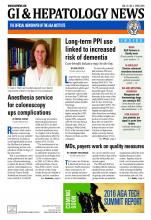For the final installment of this series, we “flashback” to our April 2016 issue, which featured a study examining 30-day complications among commercially insured adults undergoing colonoscopy with and without anesthesia-assisted sedation using Marketscan data (2008-2011).
While the costs of utilizing anesthesia assistance for an ever-increasing proportion of routine GI procedures are significant, the effect of endoscopic sedation type on patient outcomes provides the most compelling evidence for or against this practice. In this study, use of anesthesia-assisted sedation (generally with propofol) was associated with a 13% increased risk of any 30-day complication, and specifically with an increased perforation risk in those undergoing polypectomy, hemorrhage, abdominal pain, anesthesia-associated complications, and stroke (range of ORs = 1.04-1.28). However, the existence and clinical significance of this differential complication rate remains controversial. For example, a subsequent systematic review and meta-analysis (Clin Gastro Hepatol. 2017;15[12]:194-206), pooling the results of 27 studies including 2,518 patients, concluded that propofol-based sedation had a risk of cardiopulmonary adverse events similar to that of traditional agents, and a decreased risk of overall complications when used for routine GI procedures.Several letters to the editor challenged the methods used in this systematic review/meta-analysis, such that this question remains largely unresolved. What is clear is that we continue to lack an adequate understanding of which patients are most likely to benefit from anesthesia-assisted sedation, whether due to increased risk of failing standard sedation or increased risk of complications with standard sedation. This lack of clarity, as manifested in poorly specified guidelines, has fueled likely inappropriate allocation of monitored anesthesia care to low risk-patients (driven by a complex interplay of patient, provider, organizational, and economic factors), which has contributed to ballooning health care costs
and potentially impaired access for higher-risk patients in resource-limited settings. Enhanced understanding of which patients are most likely to benefit from anesthesia-assisted sedation is an essential first step in helping to define high-value use of this resource and developing more refined clinical criteria to guide sedation decision making.Megan A. Adams, MS, JD, MSc, is a clinical lecturer in the division of gastroenterology at the University of Michigan, a gastroenterologist at the Ann Arbor Mich, VA, and an investigator in the VA Ann Arbor Center for Clinical Management Research. She is an associate editor of GI & Hepatology News.





